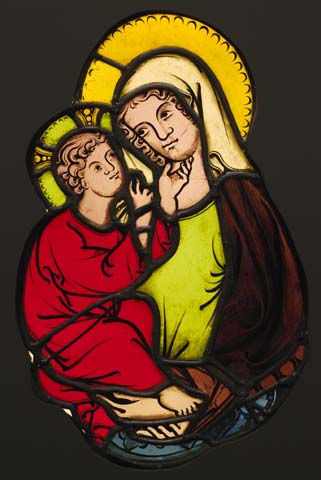The Virgin and Saint John, from a Crucifixion, German, c. 1420, Dark brown vitreous paint, colored pot metal and clear glass, silver stain, H: 58.5 x W: 50 x D: 1 cm (23 1/16 x 19 11/16 x 3/8 in.) each (J. Paul Getty Museum, 2003.35)
Why is it called stained glass?
Seraph, unknown French glass painter, working at Reims Cathedral, c. 1275–99, pot-metal and clear glass and black vitreous paint (J. Paul Getty Museum, 2003.28)
Gothic stained glass
The delicate modeling of the face and hand was done by applying vitreous paint to clear glass and then stabbing it with a broad brush to create points of light. It was then contoured with a pointed brush, creating expressive, almost calligraphic linework, as seen in the tousled hair and distraught facial features of Saint John. Originally, this would have been part of a larger Crucifixion scene.
Renaissance stained glass
Large-scale stained glass
The yellow stain is applied to the back of the panel. You can see that quite easily in the hair of the Christ child. Another wonderful aspect of these particular panels is the technique of flashed glass where you see with the halo of the Christ child. And this is made out of a piece of clear glass that’s been dipped in red and then painted with the silver stain on the back, and then the red glass has been ground away to create the rays of his halo.
A single piece of glass
Candela Citations
- Stained Glass: History and Technique. Authored by: The Getty Trust. Provided by: The Getty Trust. Located at: https://www.khanacademy.org/humanities/medieval-world/latin-western-europe/gothic1/a/stained-glass-history-and-technique. Project: Stained Glass: History and Technique. License: CC BY-NC-SA: Attribution-NonCommercial-ShareAlike









